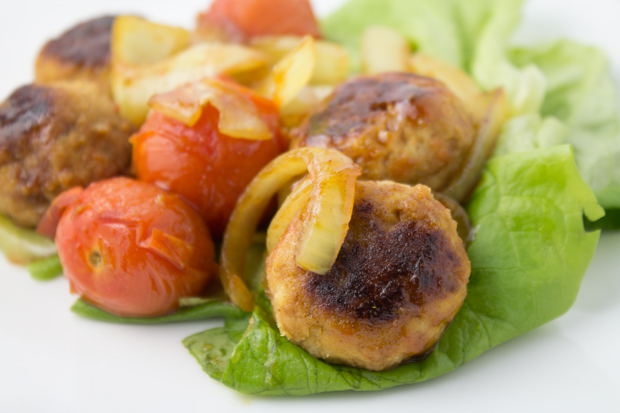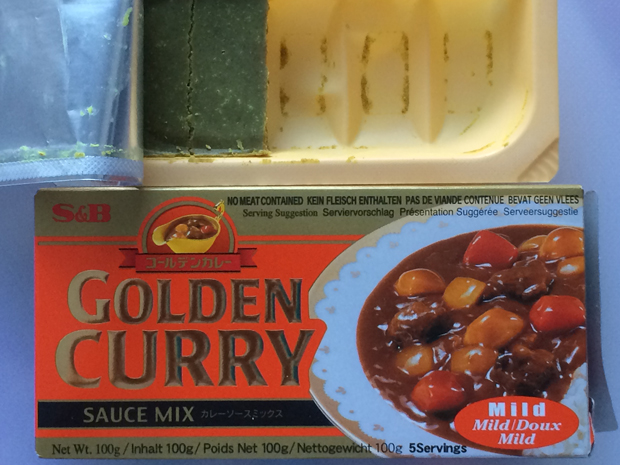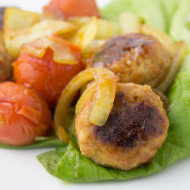Okara meatballs in Japanese curry sauce

It is a bit of a running joke in culinary circles that the Japanese can take any foreign food and change it beyond all recognition. Sometimes the results can be rather disconcerting, as happened to me at a restaurant in Tokyo claiming to specialize in Basque cuisine. The “arroz con setas” (rice with mushroom) was made with Japanese short grain rice and kinoko mushrooms and, for all I know, flavored with dashi! Ingenious, but a million miles from San Sebastian. More often though the results are both clever and extremely tasty, as with mentaiko pasta (明太子パスタ; spicy cod roe pasta) that famous fusion of Japanese and Italian. Similarly, Japanese “curry”–pronounced kare (カレー)–stands as one of the great culinary inventions of that country, on par in my opinion with instant ramen.
If you’ve never had Japanese curry, it bears little resemblance–except perhaps in color–to the Indian kind, although, “curry” itself as I’ve mentioned before is a British invention (but that’s another story). Being slight sweet I’ll admit it is a bit of an acquired taste, but one that has been hungrily latched on not only in Japan–restaurants specializing in curry are at least as common as sushi ones–but throughout the world (there are literally dozens in Manhattan alone, for example). Japanese curry roux comes in small plastic tubs (see picture below). Most commonly, you simply fry some meat, onions, carrots and potatoes. Add water and the roux and–voila!–you have a tasty stew. Not quite instant food but a great time-saving ingredient to have on hand. But curry sauce is fantastic on udon as well (カレーうどん) and, as I recently learned, on meatballs.
Not any kind of meatballs. These are made of okara, a byproduct of tofu and soy milk production. In Japan (and Korea), okara is a staple, readily-available ingredient used in everything from hamburgers to donuts. You can also buy any number of okara cookbooks, a godsend for anyone who makes tofu regularly–as I do–and is looking for ideas on what to do with leftover okara. (It freezes very well.) Today’s recipe is from one such book I happened to buy recently titled simply “Okara Recipe” (おからレシピ) by Tsutsumi Hitomi (堤 人美).

This is an easy dish to make but I recommend making the okara balls in advance (the recipe is for many more than you need for this dish, but you can freeze the rest). The rest of the recipe then comes together very quickly. Also, Japanese curry roux essentially comes in three varieties: mild, medium and hot. As far as I’m concerned even the “hot” kind isn’t spicy at all, but I’d probably start with medium if this is your first time. I promise it won’t be your last!

Okara meatballs with Japanese curry sauce
Ingredients:
Okara meatballs (makes ~30):
- 200 g okara
- 200 g pork mince
- 1 yellow onion, finely diced
- 2 Tbsp water
- 2 Tbsp sake
- ⅓ tsp salt
- 1 Tbsp olive oil
- 1 tsp soy sauce
- 1 egg, beaten
- ¼ cup sake
- olive oil for pan frying
Okara meatball in Japanese curry sauce:
- 8 okara balls
- 1 Tbsp soy sauce
- 1 Tbsp sake
- 1 Tbsp mirin
- 2 tsp curry roux (plus more to taste)
- 1 tsp sugar
- 6 cherry tomatoes
- ½ small yellow onion, cut into 1/2 cm-wide slices
- 2 tsp rapeseed any other neutral oil
- 6-7 Romaine lettuce leaves, trimmed
Directions:
Okara meatballs:
- Warm the okara for 1 min in a microwave. Transfer to a bowl and stir in the next 8 ingredients (pork through the egg). Mix well.
- Scoop a golf ball-size piece of the okara mixture and roll it into a ball. Set aside and repeat with the rest of the okara mixture. You should end up with about 30 balls.
- Heat 1 tsp of olive oil in a large nonstick frying pan over a medium flame and fry half the balls for 3 mins, turning them around every once in a while so that they're evenly cooked.
- Then, turn down the heat and add half the sake into the pan. Cover the pan with a lid and cook for another 7 mins. About half way through flip each ball over. Remove the lid, turn up the heat again to medium and cook for another 2 mins. Remove from the pan and repeat with the remaining balls.
- The balls are ready to eat or use in the following or other recipes. You can also place them in a ziplock bag and freeze them (allow to cool first).
Okara meatballs with Japanese curry sauce:
- If you're using frozen okara balls, first defrost them in a microwave.
- Mix the soy sauce, sake, mirin, roux and sugar in a small bowl and set aside.
- In a frying pan heat the oil over a medium flame. Add the okara balls and fry for 1 min. Stir in the tomatoes and onions and fry for another 2 mins, shaking the pan to cook evenly.
- Add the sauce and toss well to coat everything with it. Taste and adjust seasonings. Add 1 Tbsp water to moisten, stir one last time and transfer to plates lined with the lettuce. Serve hot.
Okara Recipe by Tsutsumi Hitomi
